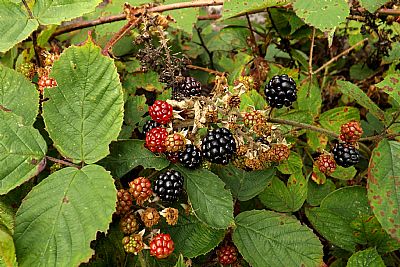BRAMBLE : BLACKBERRY : Rubus fruticosus
Also known as blackberry, European blackberry, black heg or wild blackberry. Note that while many people simply refer to this as a bramble, to be more accurate this is a blackberry. [A raspberry, for instance, also grows on a bramble].
Scourge of many a gardener especially those on the edge of towns. But loved by foragers.
Technically "bramble" can refer to raspberries, blackberries, dewberries, boysenberries, and loganberries, in fact any such plant with thorns and edible fruit. Locally though we tend to use the word for one specific plant and fruit so this is what we discuss here - in other words blackberries.
Now to get technical again' or at least some semantics. The fruit of the bramble is known as the blackberry. These ripen through green to red, then deep purple and finally, in late July, to black. But the "berry" is in fact many small fruits in a cluster; in other words an aggregate fruit.
Read more at Gardening Know How: What Are Brambles – Learn What Makes A Plant A Bramble https://www.gardeningknowhow.com/edible/fruits/fegen/what-are-brambles.htm
Looked forward to by many a forager in late summer through to October. The Wild Food UK website describes them as : Thorny as hell and a pain almost all year except when the blackberry fruits and they become a must have Autumn delight.
The Woodland Trust describes them as "Hardy and determined, the bramble uses powerful roots to grow rapidly in almost any environment". If you have them in your garden, then you will fully apreciate this. They can be very difficult to erradicate. If you think you have dug them up, a small root offshoot will come up somewhere else. They are prolific growers with some branches / shoots reaching up to 4 metres.

Early May and new growth appears, in this case on a mature long branches from last year.

A bramble in flower in early June.


Some bramble flowers can be mishapen perhaps from the weather. A near perfect flower can look like a small white rose. To the left are three leafs overlapping each other - not a single one.
Both gardeners and foragers will have great respect for their thorns. But the fruit is excellent.
The flowers appear in clusters of white or pink flowers from late spring to early summer after which the near black coloured berries appear. Don't confuse this with the wild raspberry. They are very different, but the unripened bramble berry can look similar to the rasberry which retains its redness when ripe.
Perfectly ripe bramble berries are dark and evenly formed. These are lovely to eat straight from the bush. Unripe berries are simply sour. But also look out for minute spiders that may sit in the small gaps on the fruit surface. Other than that simply try to avoid the thorns.

An unripe blackberry can look deceptively like a raspberry.

But as soon as you see a black one, you can be sure that you have the right one and that it is ripe. Even a ripe blackberry can still be sour until it is ready. If it comes away reasonbly easily in your fingers, it is more likely to be sweet, but most black blackberries can be used for cooking.

By mid-August the blackberries are abundant with a high proportion suitably ripe for eating. Any that come off easily in the hand are quite ripe. But look closely as other creatures also enjoy them. Spiders for instance.

Tiny creatures such as this aphid also enjoy them.
Bambles make excellent jam or fruit pie ingredients. There are many recipes online. Tip : Get the short-crust pastry from the freezer at your local supermarket for a very quick pie. Also see FORAGING : index.asp?pageid=731714
WIKIPEDIA : https://en.wikipedia.org/wiki/Bramble
WILD FOOD UK : https://www.wildfooduk.com/edible-wild-plants/bramble/

